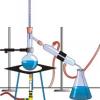Does the number of trays in simulation affect the performance?
What is the role of efficiency of the trays? What value is to be provided?
Is it possible to estimate number of trays in HYSYS?
|
|
2 replies to this topic
Share this topic:
#1

Posted 08 June 2012 - 12:10 AM
#2

Posted 08 June 2012 - 02:51 AM
as introduction to this matter I would suggest a good book as "Distillation Design" by Kister,
at design stage you (generally) solve the column for a certain number of "theoretical" trays as (usually) you do not know what type of internals will be installed,
yes, the number of trays (or stages) affects the degree of separation,
for estimating the number of "theoretical" trays and other parameters I use the Fenske-Underwood-Gilliland procedure available in Prode Properties but your simulators may include a different method,
at design stage I prefer to keep efficiency at 100% as suggested by Kister (Distillation Design) and other authors.
at design stage you (generally) solve the column for a certain number of "theoretical" trays as (usually) you do not know what type of internals will be installed,
yes, the number of trays (or stages) affects the degree of separation,
for estimating the number of "theoretical" trays and other parameters I use the Fenske-Underwood-Gilliland procedure available in Prode Properties but your simulators may include a different method,
at design stage I prefer to keep efficiency at 100% as suggested by Kister (Distillation Design) and other authors.
#3

Posted 15 June 2012 - 09:16 AM
Muralimuthu,
1) As Paulo mentioned above, the number of theoretical stages will affect your degree of separation, but usually just up to an extent. At a certain point, increasing the number of trays will not have any significant effect on your separation.
2) In a simulation you will select number of theoretical stages, not trays perse. On a theoretical stage the contact between the two phases is
assumed to be ideal which means that the liquid and vapour leaving the stage are in full equilibrium. On actual distillation trays full equilibrium is not attained at any point on the tray since the exchange of components between the phases is usually limited by the mass transfer rate. Furthermore, the actual performance of a tray will be influenced by back mixing and bypassing of the liquid and vapour phases. Consequently, when determining the actual number of (physical) distillation trays from the number of theoretical stages required for a desired separation a correction will have to be made to account for this non-ideality. This is where the tray efficiency factor comes in.The overall tray efficiency is defined as the ratio between the number of theoretical stages and actual trays:
Eff = N-theoretical/N-actual
The required number of actual trays can simply be calculated by dividing the number of theoretical stages by the overall tray efficiency.
Efficiencies are selected based on lab experiments, precision test runs and operational experience and depends on the application. If you give an idea your type of application I can suggest typical tray efficiencies.
3) In your model you will arrive at a (minimum) no of theoretical stages and coupled with the efficiency this will give you an estimate of the number of trays. There are still other factors to consider of course - tray types, spacing, downcomer types etc
Ogeds
1) As Paulo mentioned above, the number of theoretical stages will affect your degree of separation, but usually just up to an extent. At a certain point, increasing the number of trays will not have any significant effect on your separation.
2) In a simulation you will select number of theoretical stages, not trays perse. On a theoretical stage the contact between the two phases is
assumed to be ideal which means that the liquid and vapour leaving the stage are in full equilibrium. On actual distillation trays full equilibrium is not attained at any point on the tray since the exchange of components between the phases is usually limited by the mass transfer rate. Furthermore, the actual performance of a tray will be influenced by back mixing and bypassing of the liquid and vapour phases. Consequently, when determining the actual number of (physical) distillation trays from the number of theoretical stages required for a desired separation a correction will have to be made to account for this non-ideality. This is where the tray efficiency factor comes in.The overall tray efficiency is defined as the ratio between the number of theoretical stages and actual trays:
Eff = N-theoretical/N-actual
The required number of actual trays can simply be calculated by dividing the number of theoretical stages by the overall tray efficiency.
Efficiencies are selected based on lab experiments, precision test runs and operational experience and depends on the application. If you give an idea your type of application I can suggest typical tray efficiencies.
3) In your model you will arrive at a (minimum) no of theoretical stages and coupled with the efficiency this will give you an estimate of the number of trays. There are still other factors to consider of course - tray types, spacing, downcomer types etc
Ogeds
Similar Topics
Refinery Lpg Deethanizer Column DesignStarted by Guest_Ilyes_* , 15 Feb 2025 |
|

|
||
Koch-Glitsch Minivalve Trays HysysStarted by Guest_tomr91_* , 23 Jan 2025 |
|

|
||
Methanol Water Distillation ColumnStarted by Guest_Kakashi-01_* , 27 Jan 2025 |
|

|
||
Aspen V11 Help On Radfrac Distillation Column ErrorStarted by Guest_savinedanglokta_* , 13 Nov 2024 |
|

|
||
Pressure Drop Due To Entry Loss At Liquid And Gases Inside The ColumnStarted by Guest_SANDEEPCH_* , 24 Oct 2024 |
|

|

 FB
FB








